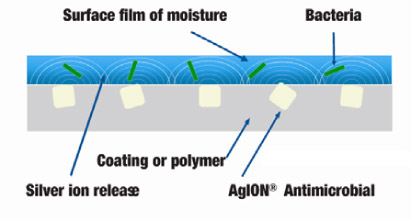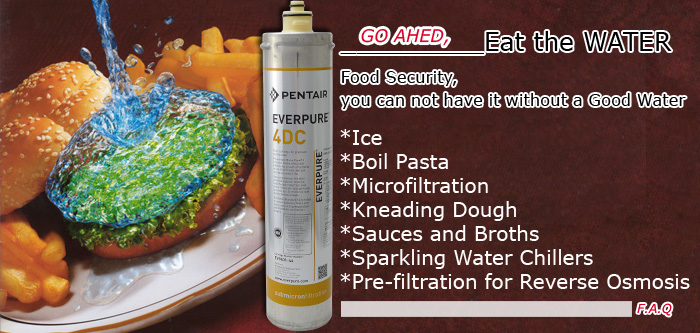 AgION Antimicrobial Silver: The Power of Silver
AgION Antimicrobial Silver: The Power of Silver
The Silver has long been valued for his antibacterial properties.
AgION Technologies, Inc.is succeed to use this antimicrobial in a secure, effective and lasting, system that can be used to fight harmful microbes in modern time.
Why microbes are a problem?
Microbes can contaminate food that we eat, water that we drink, and products that we use and touch every day - helping to create conditions of poor hygiene and cleanliness of things that surround us and reducing life and performance of the same.
What is AgION® antimicrobial compound?
AgION has developed an antibacterial compound composed by silver ions and a ceramic material known as zeolite. Its efficacy has been tested against numerous microorganisms such as bacteria, algae and fungus, molds and yeasts. Preliminary laboratory tests show efficacy of product also against viruses. AgION technology is currently used in many applications such as sportswear, footwear, pens, mobile phone, appliances like as refrigerators, air conditioner system, refrigeration and ventilation, chopping boards for kitchen, medical device, water filter, air filter, ice makers, etc..
How does AgION antimicrobial work?
The conventional disinfectants are based on a "instant kill". When applied on the surface they kill the microbe existing, but don't do much to fight regrowth. For example, a normal disinfectant instantly kill germs on taps in a public restroom, but as soon as someone touches surface of the faucet to wash your hands, tap will be re-contaminated. On the contrary AgION compound provides continuous protection against microorganisms by releasing silver ions to surface at a slow and steady pace. Silver fights microbes in three ways: breaking cellular metabolism, inhibiting transport processes in the membrane and preventing multiplication of the cells. In bathroom taps AgION compound would fight existing microbes on surface and all new microbes that will settle.
Incorporated as an additive or applied with paint, AgION compound increases life of products. The silver acts as an antimicrobial, preserves product by preventing proliferation and accumulation of bacteria that can damage over time.
AgION ® products are safe?
AgION additives are less toxic than common table salt and less irritating than talc powder. The triple attack mechanism of silver minimizes potential risk of resistance to antimicrobials that is encountered with use of many conventional antimicrobial based on chemical compounds. This is particularly important in hospital environments where antimicrobial resistance and microbial mutation are major causes of concern in the fight against disease. The advantages of silver are the reasons for its choice as standard antimicrobial in treatment of burns, where infection risks and patients sensitivity are critical aspects.
AgION additives are also environmentally safe because silver is a natural element, many other antimicrobial chemicals are not and can migrate in water and harm the environment.
What is difference between chemical and antimicrobial silver base?
The most significant difference between silver-based antimicrobials and antimicrobial chemicals is method of attack. Antimicrobial chemicals such as Triclosan, the Neosporina or oral antibiotics, typically interact with a site-specific microbe. The silver-based antimicrobials interact with different sites of microbe, using many mechanisms of attack, essentially suffocating organism.
This difference is extremely important because it is connected with antibiotic resistance problem. Microbe's resistance develops when it finds a way to react to attack mechanism. Microbes have a higher chance of developing resistance to these substances because the antimicrobial chemicals using a single mode of attack. Many of these products use a similar method of attack. If microbe develops resistance to one agent, it is very likely that it will develop the same resistance to similar mechanisms of attack's agent. The antimicrobial chemicals also are often ineffective against common bacterial species, while inorganic such as those based on silver, are broad spectrum and can kill a big variety of microbes.
Where AgION®'s products are used?
Leading companies in the fast moving consumer goods, in industry and hospital using the AgION® products to fight harmful microbes that can cause disease and significant economic losses - as additional costs to health or productivity loss of functional products.
AgION® antimicrobial additives:
• They are becoming standard solution in ventilation systems for schools and hospitals;
• Were introduced into catheters to control the spread of infections in hospitals;
• They are used water dispenser and filters to avoid biofilm formation;
• They help to reduce the risk of microbiological contamination in machine used to process foods
• Contribute to odor reduction controlling bacterial contamination in sports shoes.
The AgION® technology behind performance
The AgION ® antimicrobial is based on a mechanism of ion exchange that is safe, effective and lasting, and it provides a viable alternative to a wide range of synthetic organic chemicals. What makes our product unique is the release system. The zeolite crystal multifaceted ensures a three-dimensional release mechanism (Picture 1) and an effective release of silver ions, independently of orientation of particle in the substrate. .
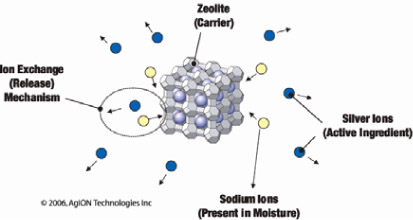 |
Activation
Silver is a powerful antimicrobial ionic form. Figure 2 shows the ion exchange process.
The zeolite's crystal containing silver ions are randomly oriented and distributed around surface of the polymer or of coating. Sodium ions in terms of bacterial growth, in humid, are exchanged with the silver in reversible exchange sites of the zeolite. Silver ions released from exchange are now available for bacterial growth's control.
Method of Growth Control
The AgION antimicrobial attack multiple targets in the microbe to prevent the growth. The silver ions interfere with the growth of cells in three ways.
They destroy the transport functions in the cell wall, inhibit the cleavage and interrupt the metabolism of the same.
In many applications AgION additives have been shown to be effective within two hours (Picture 3) while maintaining excellent performance for years.
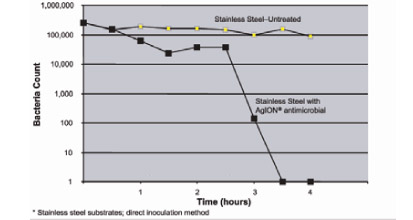 |
Registered
AgION antimicrobials are EPA registered for many applications including contact with food and water, HVAC (air conditioning), products for the construction industry, appliances, fiber and textile, cosmetics etc.
They are listed under the FDA notification of substances in contact with food, for use in all types of polymers approved for food contact in 21 CFR, Parts 174 through 186.
They are listed as USDA nonfood Compounds. They are certified NSF 51 for process foods's machine and are potentially approvable NSF Standard 42 for drinking water filters systems. Silver is listed as active substance in the Biocidal Products Directive (BPD) 98/8 EC. AgION Antimicrobial—Notification No.604..
Certifications
The World Economic Forum has named a Technology Pioneer AgION Technologies. Companies that receive this award are visionary, involved in the development of "technological innovations that will change your life and with potential long-term impact on the business to the society."
(www.weforum.org)
NSF International awarded AgION Technologies with Food Safety Leadership Awards for Technology Breakthrough.This prestigious award recognizes the efforts of outstanding individuals and organizations in the food industry who have demonstrated exceptional progress and achievement of objectives in the area of ??food safety.
(www.nsf.org)
Red Herring selected AgION Technologies among the Red Herring 100 as one of the top 100 private companies in North America. This recognition confirms that vision, team and the AgION technology can bring fundamental improvements to the "way we live and work".
(www.redherring.com)
 |
The Silver in History
4000 BC - The Egyptians used silver to protect water in tanks to reduce diseases caused by contaminated water.
1200 BC - The Phoenicians used silver-lined containers during long sea voyages to preserve the purity of water.
78 - Pliny the Elder describes the properties of silver to heal wounds.
700's - Chinese emperors used silver utensils to prevent transmission of diseases.
1000 - The Vatican decreed that the chalices for communion must be made in silver to reduce spread of diseases among the faithful and priests.
1850's - Pioneers place silver coins in milk's container and water to prevent the growth of bacteria and algae
1881 - Carl Crede, German gynecologist, first using drops of silver nitrate in eyes of newborns to prevent eye infections.
1893 - Karl Wilhelm von Ngeli, Swiss botanist, publish a research that demonstre the antibacterial properties of silver.
1900's - Several medical products based silver appear on the market, including Argyrol - a silver-based antibiotic.
1960's - NASA uses silver to purify water in spacecraft.
1970's - Silver is commonly used as an ingredient in the treatment of wounds and burns..
Companies Leaders That They use AgION® antimicrobials
Adidas - sports clothing and footwear
AK Steel - Stainless steel appliances and air ducts
Carrier - heating, ventilation, air conditioning, commercial refrigeration
Cosmetal - water dispensers
Dexter-Russell - professional cutlery
DuPont - Powder Paint for multiple applications
Ebac - Water distributors
Everpure - Water Filters
Helford - Clinical Research Hospital at City of Hope - Air conditioning system
Honeywell - Air filters
Lindab - Ventilation Systems
Motorola - Mobile phones
Neoperl - Aerators
Oster - Tools for shearing animals
Sargent / Assay Abloy - handles and locks for doors
Paper Mate - pens and pencils
Scotsman - Ice producers
Shuttleworth - systems for the transport of food
Specialty Filaments - durable synthetic fibers for bristle and brush applications
Tomlinso - Taps
Viessmann - Rooms grain cooling
Vygon - Catheters

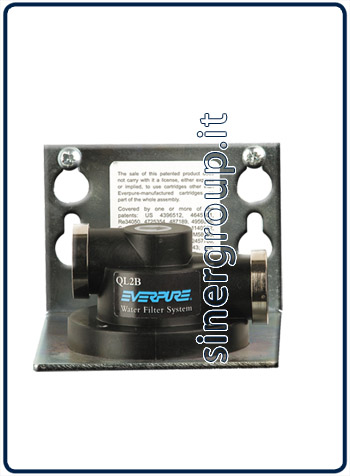

 AgION Antimicrobial Silver: The Power of Silver
AgION Antimicrobial Silver: The Power of Silver
